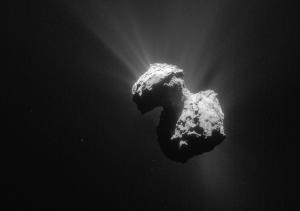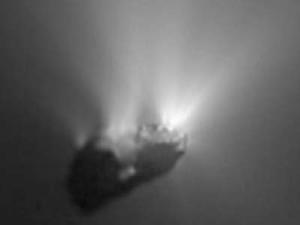Blog
Night of the Comet
7 August 2014
 ESA/Rosetta/NAVCAM
ESA/Rosetta/NAVCAMThe Rosetta spacecraft has successfully moved into orbit around 67P/Churyumov-Gerasimenko. We’ve been getting images of the comet as Rosetta approached, but now that it’s in orbit we are getting high resolution images such as the one above. You’ll notice the comet really looks like an asteroid, with what seems to be a rocky/dusty surface. That’s because comets and asteroids aren’t as different as often portrayed.
Comets are so-named because they exhibit tails of gas and dust when passing through the inner solar system. These tails are due to volatiles such as methane and water ice on the surface of the comet. We have also seen asteroids exhibit similar tails of dust, though it isn’t as common.
 NASA
NASAThis is the first time we’ve been able to place a satellite in orbit around a comet. We’ve had several flyby missions for comets, including the famous flyby of Comet Halley by the Giotto spacecraft. One huge advantage of having an orbiter is that we can make a long-term study of the comet. Rosetta has arrived at 67P/C-G just before it begins its journey through the inner solar system, so the mission will provide a first hand look at how comets are warmed by the Sun and begin to form a tail.
One of Rosetta’s first missions, however, will be to find a good landing spot for its companion spacecraft Philae. That landing should occur sometime in mid-November.